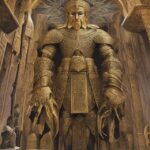Unveiling a captivating tale of revenge, redemption, and resilience, ‘The Count of Monte Cristo’ by Alexandre Dumas stands as an immortal adventure masterpiece in the world of literature. This acclaimed historical novel transcends time and transports readers to 19th-century France, where Edmond Dantès, the novel’s protagonist, undergoes a profound transformation after being unjustly imprisoned for fourteen long years. Immerse yourself in this enthralling narrative as we delve into the themes of betrayal, justice, and the undying human spirit.
By combining historic data, the author’s brilliant storytelling, this article aims to guide you through the riveting plot, intricate characters, and profound messages that lie within the pages of ‘The Count of Monte Cristo.’ Prepare to embark on an unforgettable journey of intrigue, mystery, and unyielding determination as we unravel the timeless tale that has captured the hearts of readers for generations.
Short Summary of The Count of Monte Cristo
Once upon a time, in the bustling city of Marseille, there lived a young sailor named Edmond Dantes. He was kind-hearted, hardworking, and deeply in love with a beautiful woman named Mercedes. Edmond’s life was filled with sunshine, but little did he know that a storm was brewing just above his head.
One fateful day, Edmond received a letter inviting him to the Isle of Monte Cristo. The letter promised him a great treasure for delivering a package to a fellow sailor unjustly accused of treason. Excitement filled Edmond’s heart, and without suspecting any foul play, he eagerly embarked on his mission.
However, as soon as Edmond handed over the package to his friend, he was betrayed! His so-called friend, Fernand Mondego, who had always been jealous of Edmond, framed him for treason. Edmond found himself arrested on his wedding day and taken to the infamous Chateau d’If, a desolate prison on an isolated island.
Time seemed endless within the prison walls. Edmond’s hopes began to fade, and he stoically endured years of sorrow and solitude. Yet, destiny had other plans for Edmond. One day, he met an elderly prisoner named Abbe Faria, who had been wrongly imprisoned for 14 years. The wise old man became Edmond’s mentor, teaching him various subjects, including languages, history, and philosophy.
Edmond’s thirst for knowledge coupled with the tales of immense wealth hidden on the Isle of Monte Cristo sparked a glimmer of hope within him. The two men became like father and son, sharing their dreams and ambitions. But fate had cruel intentions, and Abbe Faria’s life was cut short due to a stroke, leaving Edmond devastated yet enlightened.
Driven by vengeance, Edmond managed to escape the prison by cunningly switching places with the dead body of his mentor. He swam through treacherous waters to reach the island of Monte Cristo, where a fortune beyond his wildest dreams awaited him. With the vast treasures he discovered, Edmond transformed himself into the enigmatic Count of Monte Cristo.
As the count, Edmond embarked on a grand mission to punish those who had wronged him, using his newfound wealth and knowledge to meticulously plan his revenge. His first target was Fernand Mondego, who had stolen both his freedom and his beloved Mercedes. Countless years had passed, and Fernand had become a prominent and influential man known as the Count de Morcerf.
With his cunning manipulations, the count revealed Fernand’s hidden secrets one by one, exposing his treachery and deceit to all. The count’s incredible revenge gripped the city, leaving those around him baffled and intrigued. It seemed as if an avenging angel had descended upon Marseille.
However, amidst the count’s quest for justice, he crossed paths with two innocent souls who would alter the course of his plans. The first was Maximilien Morrel, the son of Edmond’s former employer who had shown him kindness long ago. The count saved Maximilien from despair when he tried to take his own life after his lover, Valentine de Villefort, was forced into an arranged marriage.
Valentine’s love story was woven into the intricate tapestry of revenge. The count discovered that her cruel stepmother, Madame de Villefort, had poisoned her own family members to inherit their wealth. With his love for Valentine and a desire for justice, the count intervened, foiling Madame de Villefort’s plans and allowing true love to prevail.
As the count continued his elaborate revenge, his heart began to soften. Love and forgiveness emerged from the depths of his soul, making him question the morality of his actions. He realized that revenge could not truly heal the wounds inflicted upon him.
In the end, the count found himself at a crossroads. He had extracted revenge upon those who had wronged him, but he could not escape the loneliness that lingered in his heart. He had immersed himself in a world of shadows, leaving behind the light of compassion and forgiveness.
With a heavy heart, the count made a decision. He would reveal his true identity to those he had sought revenge against, offering them a chance at redemption. The count, once Edmond Dantes, brought his enemies face to face with their sins and pleaded with them to seek forgiveness and change.
In this tale of vengeance and redemption, the Count of Monte Cristo brought justice to those who deserved it and transformed the lives of those he encountered. Edmond Dantes, who had been buried alive in the dark prison of revenge, emerged as a beacon of light, teaching us all that forgiveness is the true path to finding peace and healing the wounds of the past.
Key Theme of The Count of Monte Cristo
The Count of Monte Cristo is a novel written by Alexandre Dumas and published in 1844. It tells the story of Edmond Dantès, a young sailor who is falsely accused of treason and imprisoned on the island prison of Château d’If. After spending years in solitary confinement, Dantès manages to escape and inherits a massive fortune. Using his new identity, the Count of Monte Cristo, he seeks revenge on those who wronged him.
1. Revenge:
One of the key themes of the book is revenge. Edmond Dantès is wrongfully accused and imprisoned, resulting in the loss of his freedom, his love, and his hopes for the future. After his escape, he dedicates his life to exacting revenge on those who conspired against him. Dantès meticulously plans and executes his revenge, manipulating the lives of those who ruined his own. However, as he takes his revenge, he begins to question the morality and consequences of his actions, leading to a deeper exploration of justice and forgiveness.
2. Betrayal and Conspiracy:
The novel also explores the theme of betrayal and conspiracy. Dantès is betrayed by his closest friend, Fernand Mondego, who is driven by jealousy and the desire for wealth and power. Mondego’s betrayal sets off a chain of events that leads to Dantès’ imprisonment. The story further delves into various conspiracy plots involving different characters. These conspiracies reveal the corrupt nature of human ambition and the lengths people are willing to go to achieve their goals.
3. Identity and Transformation:
Identity and transformation are central themes in The Count of Monte Cristo. Dantès undergoes a significant transformation during his imprisonment. In Château d’If, he goes from a young and optimistic sailor to a bitter and vengeful man. Upon his escape and acquisition of wealth, Dantès assumes various false identities, each serving different purposes and allowing him to infiltrate the lives of his enemies. As the Count of Monte Cristo, he navigates a web of duplicity while also questioning his own sense of identity. This theme raises questions about the masks people wear, the influence of circumstances, and the impact of personal choices on one’s sense of self.
In summary, The Count of Monte Cristo explores themes of revenge, betrayal, conspiracy, identity, and transformation. These themes intertwine in a complex narrative, showcasing the power of human emotions, the consequences of actions, and the search for justice and redemption.
Count of Monte Cristo Main Characters List
1. Edmond Dantès: The protagonist of the story, Edmond Dantès is a young and ambitious sailor who is falsely accused of treason and imprisoned. He possesses a charming smile, bright blue eyes, and dark curly hair. Despite enduring unimaginable hardships, Dantès manages to transform himself into the mysterious and powerful Count of Monte Cristo. He exacts revenge upon those who wronged him while also seeking redemption and love.
2. Mercedes Herrera: The beautiful and loyal love interest of Edmond Dantès, Mercedes is described as having flowing chestnut hair that compliments her captivating hazel eyes. She possesses a sweet melodious voice that enchants everyone who hears it. Mercedes faces heart-wrenching decisions when confronted with the return of Edmond, as she is torn between her love for him and her current life with another man.
3. Fernand Mondego: A childhood friend turned betrayer, Fernand Mondego has a tall and imposing figure, with a face often covered by a neatly trimmed beard. He craves power and wealth, which leads him to orchestrate Edmond’s demise out of envy and greed. However, this despicable character will soon discover that actions have consequences when the Count of Monte Cristo uncovers his true nature.
4. Baron Danglars: A cold and calculating character, Baron Danglars is known for his insatiable love for money. Tall and slim, with a balding head accentuated by an extravagant comb-over, he embodies greed and opportunism. As the Count of Monte Cristo’s revenge unfolds, Danglars finds himself the primary target of his destructive plans, ultimately experiencing a comeuppance befitting his deceitful ways.
5. Gérard de Villefort: A high-ranking official with a sinister demeanor, Gérard de Villefort is described as having sharp features and piercing eyes, hidden behind a pair of spectacles. He is a ruthless man driven solely by ambition and political gain. Villefort’s complex character and involvement in dark secrets make him a perfect subject for the count’s intricate plot.
6. Haydée: A young and radiant Greek princess, Haydée is the adopted daughter of the Count of Monte Cristo. With her long ebony hair contrasted against her fair complexion, she exudes an air of mystery and elegance. Haydée’s role in the story becomes pivotal as she seeks both justice and closure for her own tragic past.
7. Albert de Morcerf: The kind-hearted and naive son of Fernand Mondego, Albert de Morcerf embodies youthful innocence coupled with a noble spirit. Tall and slender with a mop of unruly blonde hair, he becomes entangled in the Count of Monte Cristo’s plans by virtue of his family’s sins but learns valuable lessons about morality, forgiveness, and personal growth.
8. Luigi Vampa: A merciless Italian bandit and kidnapper, Luigi Vampa is known for his impeccable marksmanship, unruly black beard, and wild eyes that seem to hold secrets. Although initially presented as a villain, Luigi Vampa eventually establishes a strange alliance with the Count, proving that even the darkest characters can surprise us.
9. Caderousse: Described as a wily and cunning innkeeper, Caderousse is a hunchbacked man with a toothless grin. He often finds himself in compromising situations due to his love for alcohol and gambling. As one of the Count of Monte Cristo’s earlier targets in his revenge plot, Caderousse’s fate serves as a stark reminder of the consequences of a life consumed by greed and jealousy.
10. Lucien Debray: A charming and deceitful French diplomat, Lucien Debray possesses a dashing appearance with neatly styled chestnut hair and a perfectly groomed mustache. Often seen sporting fashionable attire, he enjoys his luxurious lifestyle to the fullest. However, his association with unsavory characters exposes him to the wrath of the Count, unveiling the true extent of his treachery.
11. Abbé Faria: A wise and charismatic old man, Abbé Faria becomes the mentor and source of divine inspiration for Edmond Dantès during his imprisonment. Despite his frail appearance, Faria’s knowledge and intellectual depth prove to be formidable weapons. His eccentricity, including constantly losing track of time, adds a touch of comedic relief to an otherwise intense tale.
12. Maximilien Morrel: A courageous and compassionate young man, Maximilien Morrel has a lean physique and intense blue eyes that reflect his determination. He serves as a symbol of hope, unwavering loyalty, and undying love throughout the story. Maximilien’s unwavering dedication to the woman he loves helps cultivate the ultimate message of redemption and forgiveness in “The Count of Monte Cristo”.
The Count of Monte Cristo: Symbols
1) The Count of Monte Cristo’s Prison Cell: The prison cell symbolizes imprisonment, both physical and psychological. It depicts the suffering and injustice endured by Edmond Dantès, the protagonist, while he was wrongfully imprisoned. Throughout the story, the prison cell represents the darkness and despair that Dantès must overcome, and serves as a reminder of the power of justice and revenge.
2) The Treasure of Monte Cristo: The hidden treasure symbolizes power, wealth, and the ability to reshape one’s fate. It represents the ultimate goal of Edmond Dantès’ revenge, which he uses as a means to attain justice and to regain control over his life. The treasure also symbolizes the corrupting influence of wealth; as the story progresses, Dantès must confront the ethical dilemmas and moral compromises that come with possessing such immense riches.
3) The Red Silk Scarf: The red silk scarf serves as a symbol of love, passion, and redemption. It is originally given to Dantès by his fiancée Mercédès before his imprisonment, representing their love and commitment. However, as the story unfolds, the scarf becomes a symbol of betrayal and ultimately leads to Dantès’ wrongful imprisonment. Later in the story, the scarf serves as a tool for reconnection and redemption, as Dantès gifts it to Albert, Mercédès’ son, symbolizing forgiveness and a new beginning. The red silk scarf thus carries both positive and negative connotations, representing the complex nature of relationships and the potential for transformation.
20 Count of Monte Cristo Quotes
Here are 20 quotes from the book “The Count of Monte Cristo” by Alexandre Dumas:
- “I am not proud, but I am happy; and happiness blinds, I think, more than pride.”
- “All human wisdom is contained in these two words – Wait and Hope.”
- “Life is a storm, my young friend. You will bask in the sunlight one moment, be shattered on the rocks the next. What makes you a man is what you do when that storm comes. You must look into that storm and shout as you did in Rome. Do your worst, for I will do mine! Then the fates will know you as we know you.”
- “It’s necessary to have wished for death in order to know how good it is to live.”
- “Woman is sacred; the woman one loves is holy.”
- “Moral wounds have this peculiarity – they may be hidden, but they never close; always painful, always ready to bleed when touched, they remain fresh and open in the heart.”
- “The difference between treason and patriotism is only a matter of dates.”
- “When you compare the sorrows of real life to the pleasures of the imaginary one, you will never want to live again, only to dream forever.”
- “How did I escape? With difficulty. How did I plan this moment? With pleasure.”
- “Learning does not make one learned: there are those who have knowledge and those who have understanding. The first requires memory and the second philosophy.”
- “For all evils there are two remedies – time and silence.”
- “All human wisdom is contained in these two words–”Wait and Hope.”
- “There are two ways of seeing: with the body and with the soul. The body’s sight can sometimes forget, but the soul remembers forever.”
- “I have always had more dread of a pen, a bottle of ink, and a sheet of paper than of a sword or pistol.”
- “We are always in a hurry to be happy…; for when we have suffered a long time, we have great difficulty in believing in good fortune.”
- “Until the day when God shall deign to reveal the future to man, all human wisdom is summed up in these two words,–‘Wait and hope.’”
- “The friends we have lost do not repose under the ground…they are buried deep in our hearts. It has been thus ordained that they may always accompany us.”
- “I am not an angel,” I asserted; “and I will not be one till I die: I will be myself.”
- “I am not a god, I am a man; I am not a hero, I am an adventurer.”
- “I am not proud, but I am happy; and happiness blinds, I think, more than pride.”
The Count of Monte Cristo: Culture Impact
The Count of Monte Cristo, written by Alexandre Dumas, has left an indelible mark on both literature and popular culture ever since its publication in 1844. This timeless tale of revenge, love, and redemption has engrossed readers across the globe, captivating the hearts and minds of generations.
Historically, The Count of Monte Cristo played a significant role in the shaping of 19th-century Europe. Set in the aftermath of the Napoleonic era, the novel explored the themes of justice and the consequences of unchecked power. Dumas ingeniously weaved historical events and figures into his narrative, providing readers with a vivid depiction of the turbulent times. This blend of historical accuracy and thrilling storytelling allowed readers to not only enjoy the book as fiction but also learn about the sociopolitical landscape of the era.
Furthermore, The Count of Monte Cristo’s impact extends far beyond its historical significance. With its intricate plot, unforgettable characters, and compelling narrative, the book has become a classic in the literary world. Its influence can be seen in subsequent works of literature, inspiring numerous authors to explore themes of revenge, betrayal, and retribution.
The book’s witty and charismatic protagonist, the Count himself, has become an iconic figure in popular culture. From adaptations for the stage and screen to various references in movies, television, and even political discourse, the Count of Monte Cristo continues to influence modern storytelling and entertain audiences of all ages. The themes and characters of the novel have become archetypes in their own right, permeating contemporary literature, film, and media with their enduring presence.
Moreover, The Count of Monte Cristo’s achievements in various forms of media adaptation are noteworthy. From successful theatre productions to numerous film versions, the story has consistently captured the imagination of audiences. The enduring popularity of the book has also led to its translation into multiple languages, ensuring its universal reach and influence on cultures around the world.
In addition to its cultural impact, The Count of Monte Cristo has provided readers with moments of sheer brilliance and humor. Dumas’ witty dialogue and well-crafted plot twists offer readers unexpected surprises, evoking both laughter and gasps of astonishment. This juxtaposition of lightheartedness and profound themes ensures that the book remains engaging and relevant even after more than a century and a half.
In conclusion, The Count of Monte Cristo has left an indelible mark on culture and history alike. Its historical accuracy, captivating storytelling, unforgettable characters, and moments of humor have secured its legacy as a literary masterpiece. From the stage to the screen and beyond, the impact of this extraordinary novel can be felt in almost every corner of popular culture, making it an enduring treasure cherished by readers worldwide.
Actors in Count of Monte Cristo
The 2002 film adaptation of “The Count of Monte Cristo” directed by Kevin Reynolds features the following actors in the lead roles:
- Jim Caviezel as Edmond Dantès
- Guy Pearce as Fernand Mondego
- Richard Harris as Abbé Faria
- James Frain as Gérard de Villefort
- Dagmara Domińczyk as Mercedes Iguanada
- Luis Guzmán as Jacopo
Other notable actors in the movie include Henry Cavill, Michael Wincott, and Helen McCrory.
FAQs
1. Who wrote “The Count of Monte Cristo”?
The Count of Monte Cristo was written by Alexandre Dumas, a renowned French author.
2. What is the book about?
The book tells the story of Edmond Dantès, a young sailor who is betrayed by his friends and wrongly accused of treason. After spending years in prison, he escapes and seeks revenge, assuming the identity of the wealthy and mysterious Count of Monte Cristo.
3. Is “The Count of Monte Cristo” based on a true story?
No, the novel is a work of fiction. However, it is inspired by real events and personalities during the early 19th century in France.
4. How long is “The Count of Monte Cristo”?
Count of Monte Cristo how many pages. The length of the book may vary depending on the edition, but it generally ranges from around 1,000 to 1,200 pages.
5. Is “The Count of Monte Cristo” considered a classic?
Yes, “The Count of Monte Cristo” is widely regarded as a classic of French literature. It has had a significant impact on popular culture and has been adapted into numerous films, plays, and television series.
6. How many chapters are in the Count of Monte Cristo?
“The Count of Monte Cristo” by Alexandre Dumas is divided into 117 chapters.
7. Where can I watch Count of Monte Cristo?
You can watch “The Count of Monte Cristo” online on Hoopla. It is also possible to rent or buy the movie on Amazon Video, Apple TV, Google Play Movies, YouTube, Vudu, Microsoft Store, and DIRECTV. The movie is available for rent at a price of $3.79 on Amazon Prime Video. You can also watch the movie on Peacock with ads.
8. When does Count of Monte Cristo take place?
“The Count of Monte Cristo” by Alexandre Dumas takes place during the years following the fall of Napoleon’s empire. The story begins in 1815 and ends in 1844. The story is set in France, Italy, and islands in the Mediterranean during the historical events of 1815–1839: the era of the Bourbon Restoration through the reign of Louis-Philippe of France.
9. Why is The Count of Monte Cristo so long?
“The Count of Monte Cristo” by Alexandre Dumas is a lengthy novel because it was originally published in serial form in the French newspaper “Le Journal des Débats” from August 1844 to January 1846. The novel was published in 18 parts, each part containing several chapters. The story is complex and has many subplots, which contributed to its length. The novel is also known for its detailed descriptions of the settings and characters, which added to its length. Despite its length, the novel has become a classic and is widely regarded as one of the greatest works of French literature.
10. Books similar to Count of Monte Cristo.
If you enjoyed reading “The Count of Monte Cristo” by Alexandre Dumas, you might also enjoy the following books:
- “The Three Musketeers” by Alexandre Dumas: This novel is another classic by the same author and is set in the same historical period as “The Count of Monte Cristo”. It follows the adventures of three musketeers and their young friend, D’Artagnan, as they fight for justice and honor.
- “Les Misérables” by Victor Hugo: This novel is set in France during the early 19th century and follows the life of Jean Valjean, a former convict who seeks redemption. The novel explores themes of justice, love, and sacrifice .
- “The Scarlet Pimpernel” by Baroness Orczy: This novel is set during the French Revolution and follows the adventures of Sir Percy Blakeney, a wealthy Englishman who leads a double life as the Scarlet Pimpernel, a daring hero who rescues French aristocrats from the guillotine .
- “The Hunchback of Notre-Dame” by Victor Hugo: This novel is set in Paris during the 15th century and follows the story of Quasimodo, a deformed bell-ringer of Notre-Dame Cathedral, and his love for the beautiful gypsy, Esmeralda. The novel explores themes of love, passion, and prejudice.
- “The Prisoner of Zenda” by Anthony Hope: This novel is set in the fictional kingdom of Ruritania and follows the adventures of Rudolf Rassendyll, an Englishman who impersonates the king of Ruritania to save the kingdom from a coup.
- “The Adventures of Sherlock Holmes” by Arthur Conan Doyle: This collection of short stories features the famous detective, Sherlock Holmes, and his loyal friend, Dr. Watson. The stories are set in Victorian England and follow the duo as they solve various mysteries.
- “The Picture of Dorian Gray” by Oscar Wilde: This novel is set in Victorian England and follows the story of Dorian Gray, a young man who sells his soul to the devil in exchange for eternal youth and beauty. The novel explores themes of morality, beauty, and corruption.
- “The Phantom of the Opera” by Gaston Leroux: This novel is set in Paris during the late 19th century and follows the story of the Phantom, a mysterious figure who haunts the Paris Opera House. The novel explores themes of love, obsession, and revenge.
- “The Adventures of Tom Sawyer” by Mark Twain: This novel is set in the fictional town of St. Petersburg, Missouri, and follows the adventures of Tom Sawyer, a mischievous young boy. The novel explores themes of friendship, adventure, and growing up.
- “The Adventures of Huckleberry Finn” by Mark Twain: This novel is set in the Mississippi River Valley during the mid-19th century and follows the adventures of Huckleberry Finn, a young boy who runs away from home and travels down the Mississippi River with a runaway slave named Jim. The novel explores themes of race, freedom, and morality.










